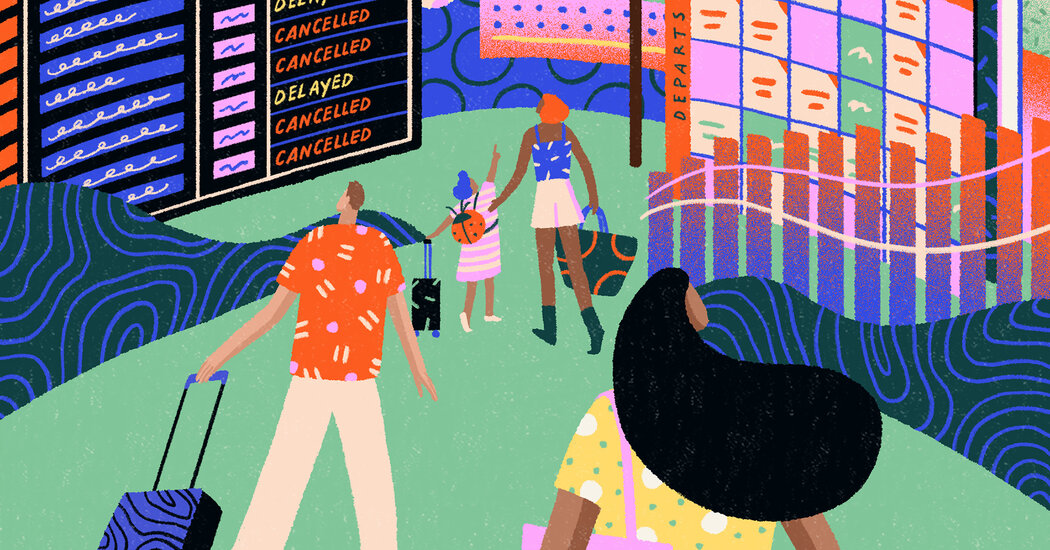
Even as inflation shows signs of slowing, airfares remain high, up nearly 10 percent in April compared with the same period in 2019, according to the Bureau of Labor Statistics. Coming out of the pandemic, fewer flights, a shortage of airline workers and higher fuel costs, have helped push prices up. And consumers, eager to travel, haven’t revolted sufficiently to persuade carriers to bring them down.
But the picture can be confusing — and changeable. According to the travel booking app Hopper, current prices on domestic airfares are well below last year right now, but are expected to rise through June when summer airfares typically peak. Hopper predicts the peak for a domestic round-trip booking will reach $328, better than the $400 last June but still 4 percent higher than the same period in 2019.
International fares, where available flights lag demand, are a bleaker story: Hopper expects tickets abroad this summer to be at a five-year high, up 32 percent to Europe compared with last summer (or $1,188 on average). Flights to Asia are up 17 percent (averaging $1,890) compared to last summer; that’s 67 percent more than in 2019.
What’s a traveler to do to keep from being fleeced? Keep an open mind.
“It’s about being flexible on one of the parameters of booking,” said Laura Lindsay, a global travel trends expert at Skyscanner, an airfare search site. “If you are flexible on when or where you want to go and even how you want to go, perhaps flying out of one airport and returning to a different one or on a different carrier, there’s a deal. If you’re rigid, you’ll be fenced into a more expensive fare.”
When you fly can be easiest to adjust. Skyscanner lets users look at prices for a route within a month’s time, letting them find the lowest fares. Google Flights sends price alerts for good fares on any dates on a specified route, and Kayak allows searches using flexible dates.
When it comes to where to go, consider 2023 a summer of spontaneity.
“Let the deal dictate the destination if you can,” said Ted Rossman, a senior industry analyst at Bankrate, a personal finance website. “So often people get their hearts set on a place and that limits their options. If you don’t care which beach, shop around.”
If you haven’t booked summer flights, do it now. Hopper generally recommends monitoring domestic fares three to four months in advance of travel — many search engines will track specified routes — and buying one to two months out. In summer, it says the best deals are often available three to four months in advance.
Another potential money saver, a practice called skiplagging, allows fliers to book a ticket with an intermediate stop in their intended destination and then skip the final leg of their trip, which can sometimes be cheaper than flying direct. The website Skiplagged assembles available deals based on your preferred airport. For example, it recently flagged a flight from San Francisco to Jacksonville, Fla., with a stop in Miami for $134. A direct flight between San Francisco and Miami was $158. The method, which the airlines hate, requires fliers to book outbound and return tickets separately and forgo checked bags.
Alternatively, look for airfare and hotel packages assembled for less than the sum of their parts. The online travel agency Priceline said its packages save an average of $240 per booking. JetBlue Vacations, a branch of the airline, said its hotel and airfare deals are better than booking separately 90 percent of the time. Shoppers can use the “Best Vacation Finder” tool to compare offers in a variety of beach destinations, mountain getaways and cities.
Finally, don’t overlook points accrued by flying or spending on credit cards as payment.
“It’s all the more important now,” Mr. Rossman said, noting that many consumers amassed stockpiles of points during the pandemic, caches at risk of devaluation by airlines, which can change the requirements at will, charging 60,000 points for a flight that was 50,000 yesterday. “Providers are recovering from the pandemic, and they want paid customers, not freebies.”

The Federal Aviation Administration says that weather is the leading cause of flight delays. But last summer, most delays were man-made, according to data from the Bureau of Transportation Statistics. From June to August last year, 8 percent of delays were caused by airlines and about 5 percent were attributed to issues with the national aviation system, which includes air traffic control problems. Less than 1 percent of the delays were weather-related, B.T.S. data shows.
The F.A.A. has recently taken steps to pre-empt potential chaos this summer. It is allowing airlines, including Delta, United and American, to operate fewer flights and instead use larger aircraft that can accommodate more passengers.
The change will help “mitigate the risk of encountering delays and cancellations,” said Michael McCormick, an assistant professor at Embry-Riddle Aeronautical University and a former F.A.A. control tower operator.
The agency has also announced 169 new routes along the East Coast that it said are more direct.
But that doesn’t mean things won’t fall apart, and knowing your rights is key.
Airlines in the U.S. are not required to compensate travelers for delays and cancellations. But all 10 major carriers will rebook passengers on another flight if the situation was under the airline’s control and will pay for meals when travelers have waited for three hours or more.
The Department of Transportation tracks delays and lays out refund and cancellation policies for controllable circumstances on its airline customer service dashboard.
Airlines might soon be required to offer cash payments, meals and hotel accommodations for carrier-caused slowdowns of three hours or more, if a rule recently proposed by President Biden and Transportation Secretary Pete Buttigieg takes effect.
Travel advisers recommended considering trip insurance, which usually covers flight delays, and checking credit card policies on reimbursements for travel mishaps. Monitoring airline apps and opting in for text updates is also a good idea, they said. And if your flight is delayed, best to stay close to the gate.
If you’ve reached frequent flier status or purchased premium tickets or priority status, there is a priority line at the check-in counter, or a phone number, where service will be faster, said James Ferrara, the founder of InteleTravel, a global travel adviser network.
Many airlines offer robust and speedy customer service through Twitter. But it’s not the only way to reach them. Call the airline’s international phone line, which won’t be as slammed in a slowdown, said Scott Keyes, the founder of Going.com, a website that sends alerts for travel deals. Delta also has a dedicated hotline for travelers with flights within the next 48 hours, Mr. Keyes added.
Self-rebooking online or through the airline’s app has also gotten easier, experts said.
Mr. McCormick advised travelers to have a backup plan should flights go awry and to select flights “wisely” by assessing your options for connecting flights. He advises avoiding routes that require you to change planes in airports where summer weather like thunderstorms and hurricanes routinely causes cancellations and delays. “Pick different flights,” he said.
One general rule of thumb for summer travel is to book flights departing before 3 p.m., Mr. Ferrara said, adding that cancellations and delays tend to occur later in the day. It’s also always an option to stay home on the holidays, when cancellations and delays tend to cluster, Mr. Ferrara said, or “consider driving.”
If possible, get a nonstop flight and don’t check a bag, Mr. Keyes said.

During last summer’s travel boom, the chief executive of Heathrow Airport in London asked airlines to stop selling tickets because of staffing shortages. Amsterdam Schiphol set a capacity cap. London Gatwick cut back on flights for July and August. Air Canada reduced its number of flights by about 15 percent.
What should travelers expect for summer 2023? And where are they most likely to run into delays and cancellations?
The flight tracking website FlightAware may offer some clues: Between Memorial Day and Labor Day in 2022, the U.S. airports with the highest number of delays and cancellations, in order, were: Newark Liberty International Airport, La Guardia Airport and Kennedy Airport in New York; Reagan National in Washington; Miami International; Orlando International; Boston Logan International; and Charlotte Douglas International, in Charlotte, N.C.
In Newark and Orlando, the worst for delays last summer, nearly 35 percent of flights departing from those airports didn’t arrive at their destinations on time. Newark also held the title for most cancellations last summer, with nearly 9 percent of flights scratched entirely.
Globally, the worst percentage of delays and cancellations, in order, were at the international airports in Toronto, Sydney, Jakarta, Amsterdam, Frankfurt, Munich and London (both Gatwick and Heathrow). Toronto Pearson stood out from the pack, with more than half of the departing flights delayed, and 7 percent of its departures canceled.
Whether these airports will again be the culprits of outsize travel misery is difficult to know. Some are taking preventive measures to try to head off the summer surge.
At Toronto Pearson, limits are being placed on the number of flights arriving and departing from the airport this summer, and improvements like contactless check-in and bolstered staffing are being put in place. Amsterdam Schiphol has no plans for a summer cap, nor does Heathrow.
In the United States, the Federal Aviation Administration published a note saying that there would be increased delays in the Northeast this summer compared with 2022, and so the agency is loosening restrictions on airlines operating in Washington, D.C., and New York to mitigate disruptions.
But there are some strategies that passengers can use to increase the chance of pain-free travel. For one, avoiding the airports with the highest levels of delays and cancellations last summer may be a good idea. And flying nonstop eliminates the risk of something going wrong with the connection. But since the worst airports are also some of the biggest hubs for major airlines, it’s not always realistic to avoid them, and depending on where you are flying from, you may be forced to connect.
But passengers can avoid traveling at peak times, such as when long-haul flights arrive, which can cause overcrowding. Most overnight long-haul flights from the United States to Europe arrive at their destination cities between 6 a.m. and noon local time. The Customs and Border Protection wait times website can give a sense of the busiest times for international flights to arrive in the United States, so you can plan around them.
Booking the first flight of the day can also be a savvy move, because if the flight is canceled, you have a better chance of getting on another flight the same day. Building in some connection cushion time is an easy way to avoid headaches.
Staying apprised as to what complications the summer weather may bring can also help. In the past, the smoke from wildfires in the Western United States has affected airports in San Francisco, Denver, Seattle and Reno, Nev. The hurricane season can cause delays at Gulf Coast and Atlantic airports like Houston, New Orleans, Miami and Atlanta. Even the heat itself can cause problems: Last summer London’s Luton airport had to shut down after scorching temperatures caused the runway to buckle, and Phoenix has faced similar issues.

More travelers may mean longer lines at airport security and customs and immigration checkpoints. The Transportation Security Administration said this week that it expects to screen 2.6 million passengers on Friday, which it predicts to be the busiest travel day of Memorial Day weekend. That’s more even than 2019, when 2.4 million travelers were screened.
In advance of the holiday, the agency said that it was taking measures to speed travelers through. Teenagers under 18 can now accompany parents or guardians who are enrolled in T.S.A. PreCheck through security when traveling on the same reservation; children 12 and under had previously been able to accompany their parents.
And the agency said its staffing levels were up because all its employees were getting a raise as of July 1. The promise of higher wages had made making recruiting efforts easier.
The agency says technology will also speed things up.
Now, at 16 U.S. airports, passengers no longer need to show their boarding passes to go through security, although they may need to show them at the gate. At these airports, travelers can swipe their identifying documents — a driver’s license or a passport, for example — in front of the security officer, and facial recognition technology will check for a match. Then an officer will check the ID before sending the passenger through.
New scanners that expedite security by allowing liquids and laptops to stay inside the bags are on the way as well, but “it’s going to be years before this becomes a reality,” said the T.S.A. press secretary, R. Carter Langston.
To speed your way, it can help to sign up for one of the programs offered by the government or Clear, a private company. But time is running out.
T.S.A.’s PreCheck program permits travelers departing from U.S. airports to go through screening without removing their shoes, belts or laptops, which can speed the process so significantly that in April, the T.S.A. said, 89 percent of PreCheck passengers waited less than five minutes in line. Many credit cards reimburse for PreCheck enrollment, which normally costs $78. And once approved, PreCheck lasts for five years. Although approval can be quick, it could take up to 60 days.
For $22 more, passengers can apply for Global Entry, which includes PreCheck, is also valid for five years and expedites entry into the U.S. from international destinations. Many credit cards also reimburse for Global Entry. The big drawback is that approval requires an interview, and the current average wait time is four to six months, Rhonda Lawson, a Customs and Border Protection public affairs specialist, said in an email. According to C.B.P., the number of travelers arriving at U.S. airports is almost 30 percent higher than last year.
If you can’t wait for PreCheck or Global Entry approval, the privately run Clear Plus offers a five-minute application and approval process. Members have their identities verified by Clear representatives and then are escorted to the front of security lines. Because users still undergo the airport’s physical screening, Clear offers maximum efficiency when used in tandem with PreCheck. Of course, the V.I.P. treatment comes at a cost: Clear runs $189 each year. But family members can be added for $60 each, and some credit cards and airlines offer discounts.
If you don’t want to pay for these programs, or don’t have the time to wait for approval, you’ve still got some digital resources at your disposal for predicting airport lines.
T.S.A. has its own app, MyTSA, that shows security wait times. Some commercial apps, like MiFlight and App in the Air, offer crowdsourced information on the current wait times at various airports.
If you’re re-entering the U.S. from abroad, the Global Entry passport-scanning kiosks now are paperless — no more receipts. Instead, your face will be scanned and then double-checked by a C.B.P. officer.
You’ll go through a similar process even without Global Entry. In the majority of U.S. airports, the passport-scanning kiosks are gone and instead a facial biometrics system is being used, said Ms. Lawson, adding that travelers can opt out and go through the traditional process by notifying a C.B.P. officer.
To get a sense of how long it might take to get through, consult the C.B.P.’s airport wait time website, which tracks the average and maximum wait times in immigration lines for both U.S. citizens and noncitizens. Although it doesn’t have real-time data, by checking the previous week’s waits on the same day and at the same time as your arrival, you can get a good sense of what kind of a line you could be facing.

Ongoing labor actions continue to wreak havoc on major European transit hubs and may upend the plans of travelers this summer.
Tens of thousands of flights and trains have been delayed or canceled in recent months as workers across European cities walked out over pay disputes and labor conditions. France and Britain have been hit particularly badly, with prolonged strikes over peak holiday periods.
In part because of the labor actions, flight cancellations in Europe rose by 65 percent in March compared with the previous month, and are expected to rise further as demand increases into the summer season, according to Cirium, an aviation analytics firm.
For travelers in the process of booking their summer trips, travel experts advise checking if flights and hotel reservations coincide with planned labor actions. Heathrow Airport in London, where members of security staff have been striking for several days each month, keeps an updated calendar of planned disruptions. In Britain, the national rail service has posted planned train strike dates through June.
In France, trade unions have been staging regular nationwide protests against a bill introduced by President Emmanuel Macron to raise the country’s retirement age by two years. Violent clashes have broken out between demonstrators and the police, causing some tourist attractions to close. Air traffic controllers and workers at SNCF, the country’s national railway operator, have walked out several times this year, and the action is expected to continue in the coming months as lawmakers discuss the draft pension bill.
In Italy, baggage handlers, pilots and flight attendants have been striking regularly over pay; a nationwide strike has been planned for June 4 that will affect buses, trams and metro lines. Train strikes across Germany have also been causing widespread disruption.
The U.S. State Department advises travelers to enroll in the Smart Traveler Enrollment Program for advisories about labor actions and other events in international destinations.
Even though the days for planned strikes are known in advance, travel agents are advising their clients to budget a few extra days in their itineraries in case they are affected by disruptions. Travelers should also familiarize themselves with their rights before embarking on their trips. Under European Union rules, travelers flying into, out of or within the bloc are eligible for a refund or a replacement flight if their flight is canceled or delayed for more than three hours. Travelers delayed overnight may also be entitled to reimbursement for personal costs, such as food and accommodations.
If informed about a cancellation less than 14 days before a scheduled departure date, passengers are entitled to up to $660 in compensation. The same rules apply to travelers to Britain.
“If your flight becomes disrupted due to an airline strike, airlines may owe you compensation ranging from $250 to $600 to make up for the inconvenience,” said Tomasz Pawliszyn, the chief executive of AirHelp, a flight claim management firm based in Berlin.
The rules apply only when the workers taking action are employed by an airline, including pilots, cabin crew, airline engineers or others who work directly for the airline. Strikes by other airport staff, including air traffic control and security, are considered to be outside of the airline’s control.

Jammed airports and planes this summer will inevitably mean more checked suitcases, duffels and backpacks that don’t show up at baggage claim.
Tight — some would even say unrealistic — flight schedules and continuing staffing shortages put pressure on luggage management systems, said Jamie Larounis, a travel industry analyst at Upgraded Points. Sometimes there just isn’t enough time to get luggage across a large airport and onto departing aircraft. “The slightest delay of a plane coming in can domino to the next because bags can’t get from one to the other,” Mr. Larounis said.
Airlines and airports are developing new technology to help those systems shepherd your bag through the conveyor belt maze quicker and more efficiently.
SITA, an air travel technology company whose WorldTracer system is in use at 2,200 airports globally, is teaming up on new initiatives. For example, it recently tested a system with Lufthansa to automatically reroute luggage that missed its flight onto the next available flight and let passengers know the new arrival time. That notification saves passengers from having to go speak to someone in the arrivals hall.
A system made by Siemens can read crumpled or partly obscured paper tags. It’s being used at several airports in the United States and internationally.
BAGTAG, a Dutch company that makes electronic luggage tags, is working with carriers like Alaska Airlines, KLM, Lufthansa and Swiss to phase out paper tags in favor of e-tags, which could help reduce mishandled luggage because they’re made of durable plastic and are less likely to be mangled or torn off.
Alaska Airlines is introducing electronic tags to a group of 2,500 fliers now and plans to make them available for sale this fall.
The good news is nearly everyone is eventually reunited with checked luggage. Last year, the vast majority made it back to their owners without a hitch. Out of the 470 million total bags checked on U.S. carriers in 2022, about six out of every 1,000 were mishandled (lost, damaged, delayed or stolen), according to the U.S. Bureau of Transportation Statistics. And only a tiny fraction of luggage is never reunited with its owner, according to SITA — about one in 2,250 bags.
So what can you do to leave the baggage carousel with a smile on your face this summer?
Arrive early so your checked bag has plenty of time to make it to the plane. Fly nonstop when possible, because every transfer increases the chance of a mishap. If you do need to change planes, don’t book a tight connection. And make sure any previous bag tags and stickers are taken off.
Carefully choose the type of bag you check (if possible, avoid the ubiquitous little black rolling bag, which can easily get mixed up at baggage claim) and festoon it with ribbons, stickers or other flair to make it easy to identify. Pay close attention at the check-in counter: Make sure the tag the agent attaches to your bag has the correct airport code. Never check medication, jewelry, or other essentials or valuables.
Take advantage of your airline’s smartphone app, which may offer luggage tracking capabilities. You can also place an Apple AirTag and a card with your contact information inside the bag to help trace it in the event it gets lost.
But say the worst happens and your baggage does not arrive as expected: Make sure you fill out the claim form before you leave the airport. The Department of Transportation website lists the rules that airlines must follow when baggage is delayed or goes missing, capping compensation at $3,800 per bag. Each airline has its own specific policies and procedures. Check their websites.

The lines aren’t just growing at the gates. They’re also getting longer inside airport lounges, longtime havens from the masses clogging the terminals at peak times.
Whether they’re taking advantage of a perk of a high-end airline ticket, a credit card or a membership program, more fliers are gravitating to the lounges — and their free food, drink and Wi-Fi.
As lounges’ popularity has grown, regular users claim they aren’t the respites they used to be, often with longer waits to get in and changes to beloved luxuries. One example: replacing seating at the bar with a rope line for walk-up service.
“The whole vibe in these clubs has changed to get passengers through, give them drinks, swipe their credit cards and sell them premium products,” said Eric Goldmann of Atlanta, who works in health care sales and flies frequently. He cited top-shelf alcohol, usually not included among the free offerings, as an example.
Airline lounges originally became popular as perks for elite or frequent fliers, and legacy carriers including American, Delta and United still reward high-status fliers with access.
But the options have increased as third-party operations have joined the fray. Methods of entry have expanded, too: fly a lot, book a first or business class seat on some flights, sign up for a premium credit card, or pay for access.
Some credit cards include lounge access as a perk. The American Express Platinum Card, which costs $695 a year (and includes $400 of total hotel and airline fee credits), grants entry to its 15 Centurion Lounges in the United States, London and Hong Kong and more than 1,400 affiliated lounges worldwide.
Other premium credit cards have followed with their own lounges. Holders of the Venture X card from Capital One ($395 annual fee with $300 in travel credits) and up to two guests have access to the Capital One Lounge in Dallas Fort Worth International Airport.
This month, JPMorgan Chase debuted its first Chase Sapphire Lounge by the Club in Boston for holders of its Chase Sapphire Reserve card ($550 a year with benefits, including $300 in credits on travel purchases).
You can also gain access through a club consortium. Standard membership in Priority Pass, a network of 1,300 airport lounges, starts at $99 a year, with each visit costing $35 at that level. Other tiers include some or unlimited free visits. (Many premium credit cards include membership in Priority Pass.)
Plaza Premium Group, which operates lounges, hotels and restaurants in more than 70 airports worldwide, sells its PPL Pass Americas for $80. The pass entitles holders to two visits within 12 months to any of more than two dozen lounges in North, Central and South America, including locations in Dallas, Newark and Orlando, Fla.
Membership in the high-end travel club Fly Lyfe starts at $28 a month and offers access to more than 600 lounges globally at $35 a visit. The price goes up to about $50 a month for complimentary lounge access.
Among membership-free clubs, Escape Lounges charge $40 if a visit is booked online 24 hours in advance, $45 if not, at 15 clubs around the country. (Escape Lounges are free to American Express Platinum cardholders.) The Club charges $50 admission at its more than 20 lounges in U.S. airports and in London. And the website LoungeBuddy identifies pay-per-visit lounges around the world.
You can also buy your way into some airline lounges. American, for example, offers one-time passes for $59 or 5,900 AAdvantage miles.
So, once you’re in, who can accompany you? Rules vary. American allows immediate family (including children under 18) or up to two guests free. Delta and United have similar policies, but include children under 21.







